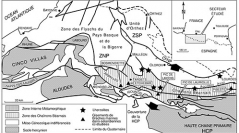

 Comptes Rendus Palevol
1 (1) - Pages 3-10
Comptes Rendus Palevol
1 (1) - Pages 3-10After the dating, by means of planktonic Foraminifera, of post-metamorphic marine breccias, Upper Danian–Lower Selandian in age, associated to hemipelagites and unconformably overlying the Cretaceous tectogenic axis of the Pyrenees from Roussillon to Bigorre, was it possible to extend westwards the breccia-filled Palaeocene ‘trough’ as far as the ‘Zone des Chaı̂nons béarnais’? This later unit, which belonged to the North-Iberian palaeomargin during Lower Cretaceous, was previously considered by several authors as characterized by an important halokinesis generating, during Aptian/?Albian, collapses of the Jurassic–Lower Cretaceous carbonate cover above dissolved salt domes and spectacular accumulations of breccias. In fact, we have everywhere identified Palaeocene planktonic microfauna within the matrix of these breccias (and within the associated hemipelagites), particularly of the reference ‘diapiric’ breccias of Etchebar, Lauriolle, Layens and Bosmendiette/Beloscare. Deposited into intra- ‘trough’ sub-marine canyons, after karstification and erosion of intermediate mountains with a steep topography previously induced by Uppermost Cretaceous compressions, the herein studied Palaeocene marine breccias should not be hereafter regarded as linked to any Lower Cretaceous diapirism on the North-Iberian palaeomargin.
breccias, submarine canyons, Foraminifera, Palaeocene, diapirism, western Pyrenees